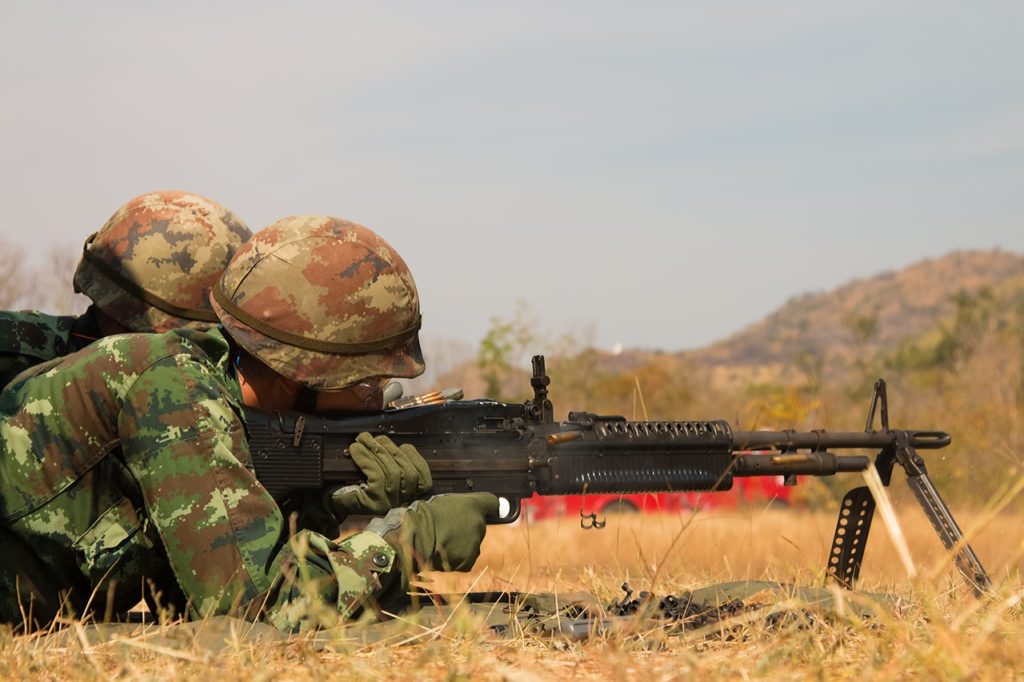
I learned this today. A machine gun works by using the recoil or the gas of the cartridge explosion to reload and re-cock the gun after each shot.
There are basically three different types of machine gun: recoil actuated, gas-operated reloading, and externally actuated. Recoil and gas-operated reloading guns follow the same theory, which is to use the cartridge’s power to load the next road and expel the fired round.
A recoil actuated machine gun uses the conservation of momentum. The forces imparted are equal but opposite in direction. That means that the force that propels the bullet out of the cartridge forward, also propels the rest of the gun backwards. This is known as the recoil. In a regular gun, the recoil will force the whole gun backward, towards the shooter. In a recoil actuated machine gun, the barrel is not fixed and is able to move. A bolt is locked in place when the gun is ready to be fired. When the trigger is pulled, the firing pin hits the ignition cap on the cartridge, igniting the gunpowder, which explodes. The bullet is forced out of the gun barrel and the explosive force makes the gun barrel move backward with the bolt. The barrel stops but the bolt keeps moving into a recoil spring. The bolt ejects the spent cartridge out of the top of the gun and the spring forces it forward again. The bolt springs back, loads a new cartridge and pushes the barrel back into place. The process is repeated until the gun runs out of rounds or the shooter takes their finger off the trigger.
A gas-operated reloading machine gun works on a very similar process except that it captures the gas expelled when the cartridge explodes to force the bolt backwards. Gases are diverted into a gas cylinder above the barrel through a vent near the muzzle. The build up of gases drives the bolt backward, ejecting the last round and loading the next. The AK-47 is a gas-operated reloading machine gun.
An externally activated machine gun uses a multi-barrel setup. Each barrel fires independently and the barrels are rotated to bring them into firing line. Early guns like this, the Gatling gun is the most famous example, were turned by a hand crank, but modern guns use a motor. When the barrels are rotated, a cartridge is loaded into the barrel at the first location, the firing pin fires the round at the next location, the empty cartridge is ejected at the next location, and then the barrel rotates back to the starting position to repeat the process. The gatling gun could fire about 500 rounds a minute and the rotating system gave each barrel chance to cool down. A single machine gun firing 500 rounds would heat up to the point where it could misfire. Modern machine operated rotary canons can fire over 6,000 rounds a minute.
The first use of a firearm was in 1288, in China. Gunpowder as an explosive was first discovered in China in the 9th century. It was used as an explosive and wasn’t used to fire anything until the 10th century when the fire lance was invented. This started out as basically a firework but evolved into an exploding rocket. By the 12th century, the cannon had been invented in China. Gunpowder was exported to Europe and the first European guns were made in the 14th century. Guns took over a minute to load. Multi-firing guns were invented in the 1500s, but without the self-contained cartridge, which wasn’t invented until 1847, machine guns were very difficult to make. Multi-firing guns would have several barrels that were preloaded and would be fired in sequence. After 1800, a lot of different guns that claimed to be able to fire multiple shots a minute were invented, but none were very successful. The gatling gun, invented in 1861, was the first machine gun to use self-contained cartridges. It became popular after the American Civil War, but they didn’t have a great range and the crews were often attacked by snipers. In 1870, the Swedish army patented a recoil-operated machine gun, but residue from the gunpowder built up and it wasn’t very reliable.
The first practical machine gun was invented in 1884 by Sir Hiram Maxim. The First World War saw a huge advance in machine gun technology and the guns were mounted on aircraft. The first handheld submachine guns were invented at the end of the war. Technology has continued to advance and these days a machine gun can fire 500 to 1000 rounds per minute.
Machine guns work by either using the recoil of the gun or the gas from the cartridge to force a bolt back to eject the spent cartridge and load the next cartridge. There are externally operated machine guns that use a handle or a motor to rotate. And this is what I learned today.
Photo by Somchai Kongkamsri from Pexels
Sources:
https://en.wikipedia.org/wiki/Firearm
https://en.wikipedia.org/wiki/Fire_lance
https://www.brown.edu/Departments/Joukowsky_Institute/courses/13things/7687.html
https://www.pbs.org/opb/historydetectives/technique/gun-timeline/
https://science.howstuffworks.com/machine-gun.htm
https://en.wikipedia.org/wiki/Machine_gun
https://en.wikipedia.org/wiki/Maxim_gun
https://en.wikipedia.org/wiki/Vickers_machine_gun
https://en.wikipedia.org/wiki/M61_Vulcan
https://en.wikipedia.org/wiki/AK-47
https://en.wikipedia.org/wiki/Recoil_operation
